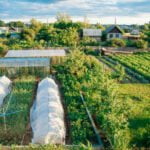Are you interested in starting a vegetable garden in Arizona? Whether you’re new to gardening or an experienced green thumb, understanding the unique challenges and opportunities of Arizona’s climate is crucial for successful vegetable gardening.
In this article, we will explore the ins and outs of Arizona vegetable gardening, including the best vegetables to grow, planning your garden for optimal timing, a month-by-month guide for gardening tasks, tips for success, and dealing with Arizona-specific garden pests and diseases. By the end of this article, you’ll be well-equipped to start your own thriving vegetable garden in Arizona.
When it comes to vegetable gardening in Arizona, one key factor to consider is the state’s distinctive climate. With its hot and arid conditions, understanding how to work with the weather is essential for growing a successful garden. From frost dates to extreme summer temperatures, being aware of these climatic factors can make all the difference in what you choose to grow and when you choose to plant.
In addition to climate considerations, it’s important to select vegetables that are well-suited for Arizona’s specific growing conditions. Not all plants thrive in the intense heat or have tolerance for the potential frost during winter.
Choosing vegetables that are resilient and adapted to Arizona’s climate can increase your chances of a bountiful harvest. Throughout this article, we will delve into the best vegetables suited for Arizona’s unique environment and provide insights into how to plan your garden accordingly.
Understanding the Arizona Climate for Vegetable Gardening
Arizona’s unique climate presents both challenges and opportunities for vegetable gardening. With its hot, arid summers and mild winters, Arizona offers a long growing season for many types of vegetables. Understanding the local climate is essential for successful gardening in the state.
The first step in understanding the Arizona climate for vegetable gardening is to familiarize yourself with the state’s different climate zones. The vast variation in elevation and topography across Arizona contributes to a wide range of microclimates.
For example, areas in higher elevations such as Flagstaff experience cooler temperatures and shorter growing seasons compared to low-lying desert regions like Phoenix or Tucson. Knowing your specific zone will help you choose the right vegetables to grow and determine the appropriate planting schedule.
Another key aspect of the Arizona climate is its extreme heat during the summer months. This high temperature can pose a challenge for many vegetables, so selecting heat-tolerant varieties is crucial. Additionally, providing ample irrigation and shade can help protect plants from excessive heat stress. On the other hand, mild winters offer an opportunity to grow cool-season crops without fear of frost damage that gardeners in other regions face.
Understanding these climate nuances will enable you to make informed decisions when planning and tending to your vegetable garden in Arizona. Consider consulting an Arizona vegetable gardening calendar for more specific guidance on what to plant when based on your location within the state.
| Arizona Climate Zones | Key Considerations |
|---|---|
| Low-desert regions (e.g. Phoenix, Tucson) | Long hot summers; select heat-tolerant varieties; provide shade and ample irrigation |
| High-elevation areas (e.g. Flagstaff) | Cooler temperatures and shorter growing seasons; choose cold-hardy crops |
Best Vegetables to Grow in Arizona
When it comes to vegetable gardening in Arizona, the key to success lies in choosing the right vegetables to grow. With the state’s unique climate and soil conditions, some vegetables thrive better than others. Here are some of the best vegetables to grow in Arizona:
- Tomatoes: Tomatoes are well-suited for Arizona’s warm and sunny climate. They can be grown in both spring and fall, producing abundant crops if given proper care.
- Peppers: Whether it’s bell peppers, chili peppers, or sweet peppers, they all do well in Arizona. With proper watering and ample sunlight, peppers can yield a bountiful harvest.
- Cucumbers: Cucumbers are ideal for Arizona gardens, especially during the warmer months. They require regular watering and a trellis for support as they grow.
- Zucchini: Zucchini plants are prolific producers in Arizona’s growing conditions. With rich soil and consistent watering, you can expect an abundance of zucchinis throughout the season.
- Green Beans: Both bush and pole beans thrive in Arizona’s warm weather. These heat-tolerant vegetables can be planted in succession for continuous harvests.
In addition to these vegetables, other suitable options for Arizona vegetable gardening include eggplant, squash, melons, and leafy greens such as lettuce and spinach. By selecting the right vegetables that are compatible with Arizona’s climate, gardeners can enjoy a successful and rewarding harvest.
It is important to note that while these vegetables thrive in Arizona, proper care must still be taken to ensure their health and productivity. Paying attention to watering schedules, soil quality, and potential pest control measures will contribute greatly to a successful vegetable garden.
Planning Your Arizona Vegetable Garden
When planning a vegetable garden in Arizona, one of the most important factors to consider is the timing of planting. The state’s unique climate and weather patterns mean that the traditional guidelines for planting vegetables may not apply. Understanding the best dates and timing for planting your vegetables is crucial for a successful harvest.
In Arizona, the timing of planting your vegetables depends on the two major growing seasons: spring and fall. The best approach is to plan your garden around these seasons, as summer can be extremely hot and challenging for many vegetable crops. For spring planting, it is recommended to start seeds indoors in late winter and then transplant them into the garden after the last frost date, which varies depending on your specific location in Arizona.
For fall planting, it is essential to start seeds indoors in late summer and then transplant them into the garden as temperatures begin to cool down. Some cool-season crops like lettuce, spinach, and kale actually thrive in Arizona’s mild fall and winter weather. By understanding these specific dates and timing for each growing season, you can maximize your chances of a bountiful harvest from your Arizona vegetable garden.
Utilizing resources such as the Arizona Vegetable Gardening Calendar can also provide valuable information on specific planting dates and timings for various vegetables. This calendar takes into account the unique climate of Arizona and provides month-by-month guidelines for when to plant different vegetables based on their ideal growing conditions. By following these recommendations closely, you can optimize the productivity of your garden throughout the year.
Arizona Vegetable Gardening Calendar
January
In January, Arizona gardeners should focus on cool-season crops such as lettuce, spinach, kale, and peas. These vegetables thrive in the cooler temperatures of winter and can be started from seeds or transplants. It’s also a good time to start preparing the soil for the upcoming growing season by adding organic matter and compost.
February
February is the perfect time to start planting potatoes in Arizona. This month also marks the beginning of the planting season for warm-season crops such as tomatoes, peppers, and eggplants. Be sure to protect these tender young plants from late frosts by covering them with row covers or cloches.
March
As spring arrives in Arizona, gardeners can continue planting warm-season vegetables such as cucumbers, squash, and melons. It’s also a good time to add heat-loving herbs like basil and cilantro to your garden. Be mindful of watering needs as temperatures begin to rise, and consider using mulch to retain soil moisture.
As you plan your Arizona vegetable garden throughout the year, keep in mind that the specific timing of planting and harvesting may vary depending on your specific location within the state. By following an Arizona vegetable gardening calendar that takes into account these regional differences, you can maximize your chances of success and enjoy a bountiful harvest from your garden.
Tips for Successful Vegetable Gardening in Arizona
When it comes to successful vegetable gardening in Arizona, there are a few important tips to keep in mind. The extreme heat and dry climate in most parts of the state make vegetable gardening a bit more challenging compared to other regions. However, with the right knowledge and strategies, you can still enjoy a bountiful harvest of fresh, homegrown produce.
Watering Strategies
One of the biggest challenges for Arizona gardeners is the lack of water and the high evaporation rates. It’s crucial to develop effective watering strategies to ensure that your vegetables receive enough moisture without wasting water. Drip irrigation systems are highly recommended as they deliver water directly to the plants’ roots, minimizing evaporation and water waste.
Soil Preparation
Arizona’s soil tends to be sandy or rocky, which can pose challenges for vegetable gardening. Adding organic matter such as compost or well-rotted manure can improve soil structure and fertility. Additionally, using mulch around your plants can help retain moisture and regulate soil temperature.
Shade and Sun Protection
Protecting your vegetables from the scorching Arizona sun is essential for their overall health and productivity. Consider using shade cloth, row covers, or planting taller crops as natural sunblock for your delicate veggies. It’s also important to plant at the right time of year, taking into consideration each crop’s specific sun exposure needs.
By following these tips and staying informed about the best practices for vegetable gardening in Arizona, you’ll be well on your way to a successful harvest of delicious, homegrown produce all year round. Remember to refer to the Arizona Vegetable Gardening Calendar for specific month-by-month guidance on when to plant and care for various vegetables in this unique climate.
Dealing With Arizona-Specific Garden Pests and Diseases
When it comes to vegetable gardening in Arizona, it’s important to be aware of the specific pests and diseases that are common in this region. Dealing with these issues effectively can mean the difference between a successful harvest and disappointment. Here are some common pests and diseases in Arizona and how to manage them:
1. Aphids: These tiny insects can cause damage to your vegetable plants by sucking sap from the leaves, causing them to wilt and distort. To manage aphids, you can try introducing natural predators like ladybugs or lacewings to your garden. Additionally, you can use insecticidal soap or neem oil as organic control methods.
2. Whiteflies: Whiteflies are another common pest in Arizona that can cause significant damage to your vegetable plants. They feed on the underside of leaves, causing them to turn yellow and eventually die. To control whiteflies, you can try using reflective mulch to deter them, or introduce natural predators like parasitic wasps.
3. Powdery mildew: This fungal disease thrives in warm, dry climates like Arizona. It appears as a powdery white coating on the leaves of affected plants, ultimately reducing their ability to photosynthesize and produce fruit. To prevent powdery mildew, make sure your plants have good air circulation and avoid overhead watering.
By being proactive in managing these common pests and diseases in Arizona vegetable gardens, you can help ensure the success of your harvest throughout the growing season.
Harvesting and Enjoying the Fruits of Your Arizona Vegetable Garden
In conclusion, the Arizona Vegetable Gardening Calendar is a valuable resource for anyone looking to start or improve their vegetable garden in the state. By understanding the unique climate of Arizona and the best vegetables to grow in this region, gardeners can maximize their success. The calendar provides a month-by-month guide for planning and timing, ensuring that gardeners are prepared for each stage of the growing season.
One of the key takeaways from the Arizona Vegetable Gardening Calendar is the importance of proper timing for planting and harvesting. By following the suggested dates and timeline, gardeners can optimize their yield and enjoy a bountiful harvest. Additionally, the calendar offers tips for dealing with Arizona-specific garden pests and diseases, helping gardeners protect their crops and ensure a successful growing season.
Ultimately, by carefully following the guidance provided in the Arizona Vegetable Gardening Calendar, gardeners can reap the rewards of their hard work. From planting to harvesting, this comprehensive resource equips individuals with all they need to know for successful vegetable gardening in Arizona. Whether you’re a beginner or experienced gardener, this calendar is an invaluable tool for cultivating a thriving vegetable garden in this unique and challenging climate.
Frequently Asked Questions
When Should I Start a Vegetable Garden in Arizona?
In Arizona, the best time to start a vegetable garden is in late February or early March. This allows for planting before the extreme heat of summer arrives, giving the vegetables enough time to grow and mature.
What Is the Easiest Vegetable to Grow in Arizona?
One of the easiest vegetables to grow in Arizona is the cherry tomato. These plants thrive in the hot and dry climate of Arizona and require minimal maintenance. They also produce fruit continuously throughout the growing season.
Can You Grow a Garden Year Round in Arizona?
Yes, it is possible to grow a garden year-round in Arizona, particularly in the southern parts of the state where the climate is warmer. With careful planning and selection of heat-tolerant vegetables, it is feasible to have a continuous supply of fresh produce throughout the year.

If you’re looking to get into vegetable gardening, or are just looking for some tips on how to make your current garden better, then you’ve come to the right place! My name is Ethel and I have been gardening for years. In this blog, I’m going to share with you some of my best tips on how to create a successful vegetable garden.





